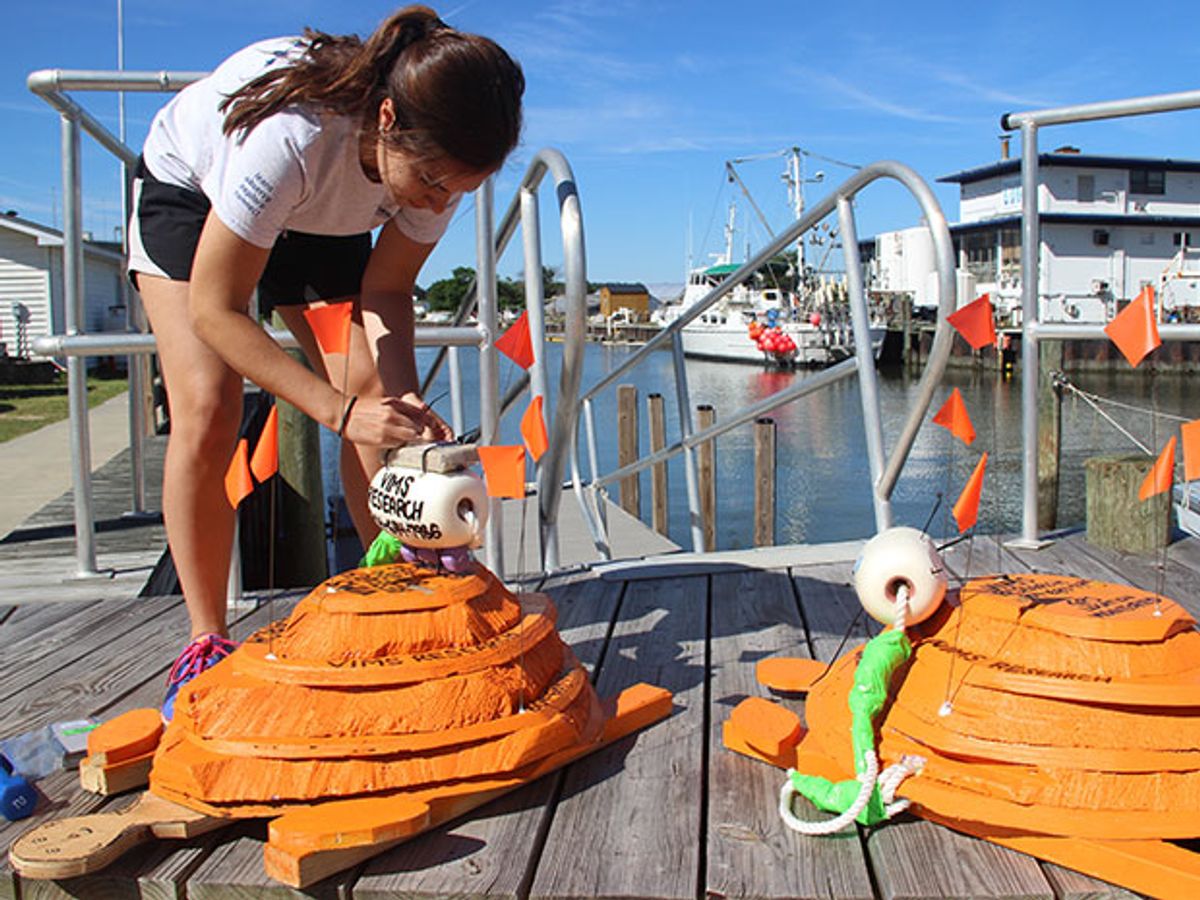Hundreds of dead sea turtles wash up on the shores of Chesapeake Bay each year. Strangely, these events known as strandings seem to occur more often along certain stretches of shoreline. But even while so many turtles wind up in these spots, no one knows exactly where they’re coming from or how most of them died.
To try to figure it out, a master’s student is setting a handful of GPS-equipped turtle carcasses afloat in Chesapeake Bay this summer. Bianca Santos, a graduate student at William and Mary’s School of Marine Science at the Virginia Institute of Marine Science, released two so-called “drifters” from a boat last week and hopes to launch up to 10 this season.
She hopes that by tracking how the carcasses are pushed along by wind and ocean currents, she can figure out where those hundreds of beached turtles floated in from, and whether some spots in the ocean might prove more deadly to turtles than others.
In Chesapeake Bay, between 250 and 350 turtles are stranded each year. That count is likely an underestimate, because many deceased turtles never make it to shore. All five of the turtle species found in Chesapeake Bay are either endangered or threatened.
“There's plenty of turtles that we just can't tell what killed them, so having location information would be helpful,” saysDavid Kaplan, a fisheries scientist at VIMS and Santos’ advisor.
Admittedly, no one knows if the experiment will work. Santos and Kaplan are only running a small batch of tests, since turtle carcasses are difficult to obtain. Even if they successfully retrace the paths of stranded turtles, that exercise may not lead them to any obvious causes of death.
The Virginia Institute of Marine Science, which runs a program to monitor stranded turtles, has so far provided two carcasses for the experiment. Once the turtles were in their possession, the team’s next challenge was finding space to store them. “What we've found out is that a turtle does not fit conveniently into a freezer,” Kaplan summarizes.
[The following description is not fit for those who may become queasy at the mention of turtle innards.] To prepare the carcasses for their float, the team carved out the turtles’ internal organs, sprayed Styrofoam to fill the empty shells, and secured the shells shut with zip ties. Then, the pair threw the carcasses in the Bay to make sure that they would stay adrift.
“That sort of took awhile, to figure out, how do you make turtle carcasses float?” Santos recalls. When real turtles die, they initially sink but become buoyant again as their decomposing tissues emit gases.
Next, the duo added a TrackPack GPS unit, which is about the size of a deck of cards, by stringing it to a buoy that would float alongside each carcass. They considered affixing the GPS unit atop the turtles’ shells, but were concerned that waves might flip the carcasses over.
The GPS units send each drifter’s location data through the privately-run Tracker Remote Access Satellite Sensor Link System, which relies on the Globalstar constellation of 48 satellites.
In addition to the carcasses, the group is also releasing turtle-like drifters built of balsa wood, and plain plastic buckets filled with water. They expect the buckets to follow a different trajectory than the wooden models and carcasses, which float slightly above the water and are affected by wind as well as water currents.
“What we're really trying to determine is how much wind is changing [the drifters'] trajectories in addition to just water drift,” Kaplan explains.
The carcasses are not generally reusable, but the group’s plan was to at least recover the GPS units from each drifter as they wash ashore and attach those units to a new carcass or drifter for another run. Each GPS unit costs about $350, and represents their primary equipment expense.
Already, they’ve had trouble recovering one of the two GPS units released last week because the carcass it was affixed to ran aground in a marsh and couldn’t be reached by boat or on foot. To rescue the other one, Santos had to drive more than an hour and knock on the door of someone whose private stretch of beach their carcass had landed upon. Last week the team launched a GoFundMe campaign partly to raise funds to help replace equipment lost on each drifter that escapes.
By summer’s end, Santos wants to see if her team can work backward from their data to identify where most stranded turtles that wind up on the beach are originating. To do that, they’ll pair an open-source Java tool called Ichthyop—originally developed to predict the movement of plankton in ocean currents—with the Regional Ocean Modeling System, which can be used to simulate waves, winds, and currents.
If they succeed, they may be able to identify a potential cause of death in that area, such as boat strikes, entanglement in fishing nets, and “cold stunning,” a hypothermic reaction that is more common in winter but can happen year-round.
For now, no one is sure why so many sea turtles die each year. “I think it is sort of a big mystery,” Santos says.



